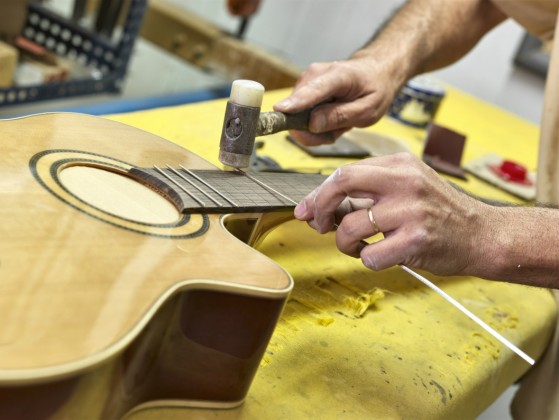Parts of the guitar, the frets
The frets are considered standard elements of the guitar, but there is nothing further from the truth, we can find several sizes.
The height and thickness of the frets as well as the hardness will condition the features of the guitar and the kind of music.
In previous publications, we have discussed the string action, the distance between the strings and the tuning fork. The higher the action of the strings is, the greater amount of sound is achieved. This is because the string has more space to vibrate; and therefore, it sounds more.
Dryness is also very important, since it could directly affect the area of the neck, because the wood shrinks and the frets could jut out from the neck.
WHEN THE FRETS ARE LOW
The fact that they are low is interesting to move easily on the neck, although it makes a little bit difficult the performance of the vibratos.
If we talk about low, but narrow frets, the instruments will be very oriented to perform rhythmic functions of accompaniment. Moreover, these features decrease the use of some techniques, so it is possible that it is more difficult to get a "clean" sound.
If we apply this logic, we can suppose that using frets with a medium width and height, we could get a suitable instrument to fulfill the functions of accompaniment, as well as being able to act as soloist.
An average size provides versatility to perform different styles.
WHEN THE FRETS ARE HIGH
Many times we talk about "sustain", well, this type of frets provides a greater "sustain" in the performance, in other words, a longer vibration of the strings.
Being high, there is less contact with the fingerboard, which offers a higher speed. This condition also facilitates the interpretation of legatos or vibratos.
In the same way, tuning problems can arise if we apply too much pressure to the strings.
If they are also wide, we will achieve higher comfort on the left hand to move through the fingerboard, but they will wear out more easily.
THE IMPORTANCE OF THE INSTALLATION
The installation is also an important factor to take into account. If deep splits are made in the fingerboard, the stability or rigidity of the neck can decrease; it is something that would go against the "sustain".
THE “SALLOPED” EFFECT
In order to obtain higher frets and more space of the vibration of the string; in the past, the denominated "Salloped" system was used. This system consists in lowering the fingerboard between "metals" in order to get greater distance to the string.
In this way, the space between the metallic elements is not flat, since it has a concave shape.



